1. Overview
Katarina Witt, born on December 3, 1965, in Staaken, East Germany, is a German former figure skater widely considered one of the greatest ladies' singles skaters of all time. Her career, deeply intertwined with the East German state sports system, saw her achieve unparalleled success, including two consecutive Olympic gold medals in 1984 and 1988, four World Championship titles, and six consecutive European Championship titles. Beyond her athletic prowess, Witt captivated audiences with her charismatic performances and glamorous image, becoming a global icon. Her post-amateur career included professional ice shows, acting, and diverse public engagements, notably her powerful comeback at the 1994 Winter Olympics where she represented a reunified Germany with a poignant message of peace for Sarajevo. However, her life also revealed the pervasive influence of the East German state, as later declassified files from the Stasi detailed extensive surveillance and efforts to control her. Witt's journey reflects both extraordinary personal achievement and the complex social and political realities of living under an authoritarian regime, providing a significant case study of state power versus individual freedom.
2. Early Life and Background
Katarina Witt's early life unfolded within the structured society of East Germany, where her athletic potential was recognized and nurtured from a young age.
2.1. Childhood and Education
Witt was born on December 3, 1965, in Staaken, a district that was then part of Falkensee, situated just outside West Berlin and now part of Berlin. Her family consisted of her mother, who worked as a physiotherapist, and her father, a farmer. She attended school in Karl-Marx-Stadt, which is now known by its pre-war name, Chemnitz. In Karl-Marx-Stadt, she was enrolled in the Kinder- und JugendsportschuleGerman, a specialized sports school designed to identify and develop athletically talented children within the East German system. This educational path provided a rigorous foundation for her future competitive career.
2.2. Entry into Figure Skating
Katarina Witt began her formal figure skating training and entered the competitive scene under the guidance of coach Jutta Müller in 1977. Müller's coaching philosophy was demanding, with Witt training six days a week, often for up to seven hours a day. A significant portion of this training, approximately three hours daily, was dedicated to practicing compulsory figures, a foundational element of figure skating at the time that required precision and technical mastery. Witt represented the SC Karl-Marx-Stadt club throughout her amateur career for East Germany.
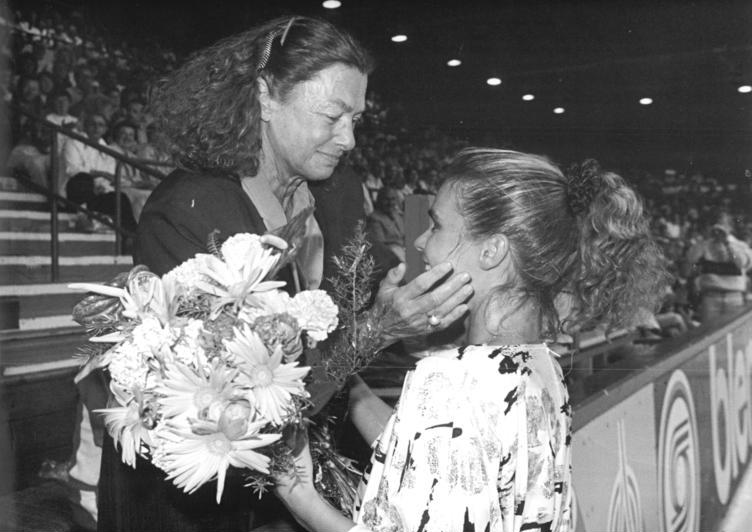
3. Competitive Career
Katarina Witt's competitive figure skating career was marked by a series of remarkable achievements that cemented her status as one of the sport's most dominant figures.
3.1. Early Competitive Years
Witt made her debut in major international competitions at the 1979 European Figure Skating Championships, where she placed 14th. Her talent quickly became apparent, and at the 1981 World Figure Skating Championships, she performed exceptionally well in the short program, finishing first, and placed third in the long program. However, due to her lower placement in the compulsory figures, she narrowly missed a medal. The following year, 1982, marked her first appearances on a major podium, as she secured silver medals at both the 1982 European Figure Skating Championships in Lyon and the 1982 World Figure Skating Championships in Copenhagen. At the 1982 World Championships, she had a strong opportunity to win gold, needing only to secure victory in the long program. Despite being the first woman to successfully land a triple flip jump, she made critical errors in her long program, stepping out of three jumps, including her renowned triple flip and a relatively simple double axel. This cost her the long program win and the overall gold medal, which ultimately went to Elaine Zayak of the United States. In the subsequent 1982-1983 season, Witt claimed her first European title in Dortmund. However, at the 1983 World Figure Skating Championships, she finished off the podium in fourth place. This was primarily due to her eighth-place finish in compulsory figures, even though she won the combined free skating segment.
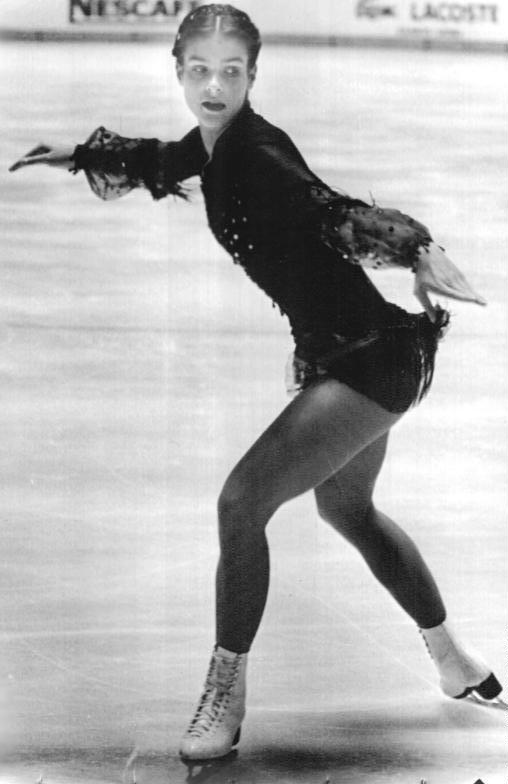
3.2. Rise to Olympic Stardom (1984-1988)
The period between 1984 and 1988 saw Katarina Witt rise to international prominence, capturing multiple Olympic and World titles and becoming a symbol of East German athletic success. During this time, she won ten gold medals out of eleven major international events. In 1984, readers of the East German newspaper Junge Welt voted her "GDR Female Athlete of the Year."
3.2.1. 1984 Sarajevo Olympics
Katarina Witt secured her first Olympic gold medal at the 1984 Winter Olympics in Sarajevo, Yugoslavia (now Bosnia and Herzegovina). Heading into the free skate, which accounted for fifty percent of the total score, Witt and reigning World champion Rosalynn Sumners of the United States held the top two positions. Witt executed three triple jumps in her free skate. The judges' scoring allowed room for Sumners to win the event, but Sumners scaled back two of her planned jumps. Ultimately, Witt won the long program by a narrow margin of one-tenth of a point on one judge's scorecard, securing the gold medal. At the age of 18 years and 77 days, she became one of the youngest Olympic figure skating champions. Following her Olympic triumph, Witt went on to win her first World title in Ottawa in dominant fashion, winning all three phases of the competition, with Sumners not competing.
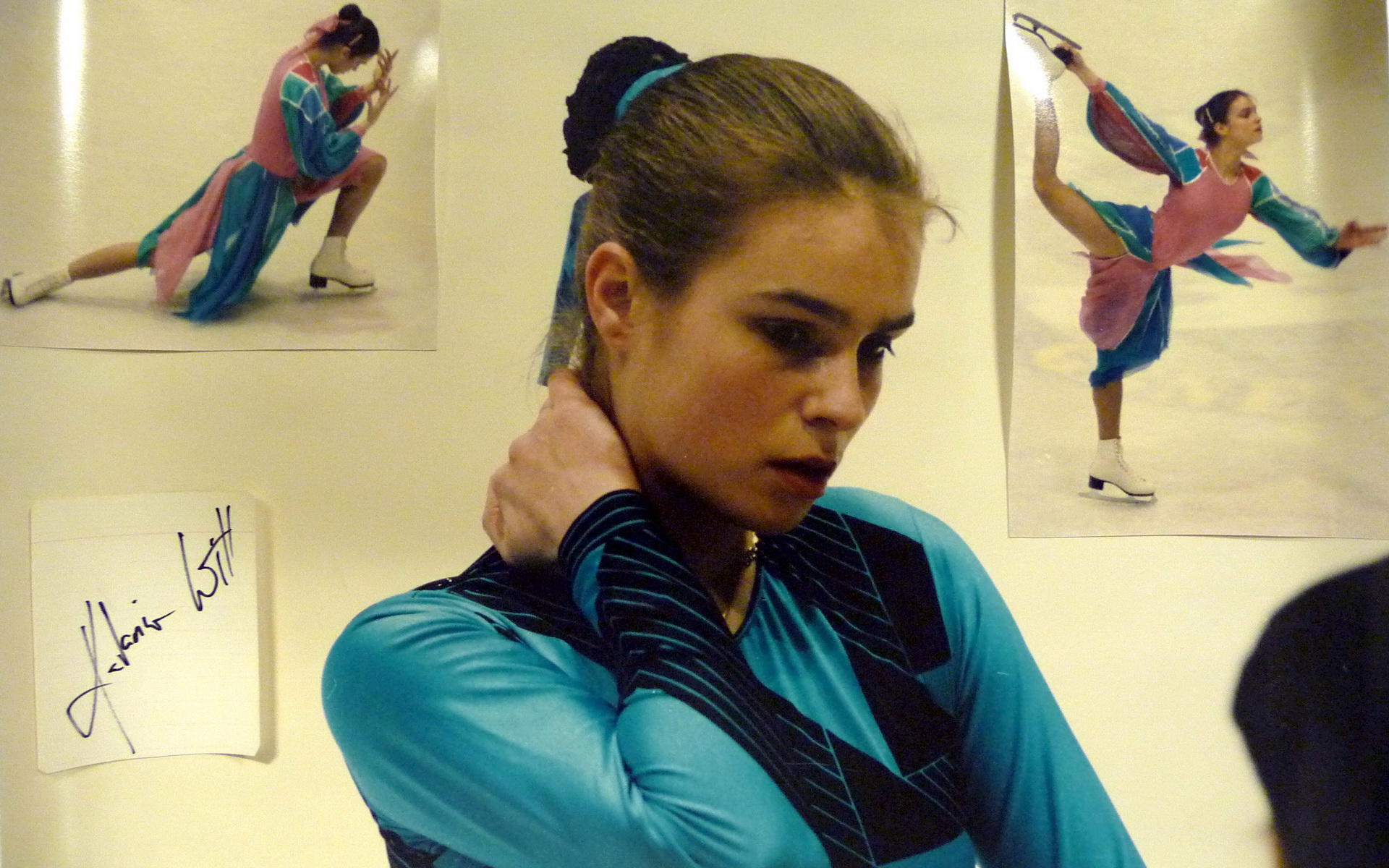
3.2.2. "Battle of the Carmens" and 1988 Calgary Olympics
Witt successfully defended her World title in 1985 in Tokyo. She delivered solid and clean performances across all three phases, placing third in compulsory figures behind her main rivals, Kira Ivanova and Tiffany Chin. She convincingly won the short program, even against the clean skates of Ivanova and Chin. In the long program, Ivanova presented a strong challenge with a clean three-triple program, including a difficult triple loop. However, Witt surpassed her with a four-triple long program, showcasing her superior artistry. She overtook Ivanova by a 6-3 judges' split in both the long program and overall. The judges also left room for Chin to win the long program and the event, but Chin fell on a double axel and did not complete a planned triple salchow, ultimately settling for the bronze medal.
Her long-standing dominance was briefly interrupted at the 1986 World Figure Skating Championships in Geneva, where she placed second to American Debi Thomas, the new United States Champion. Although Witt won the long program over Thomas with two perfect 6.0s for artistic impression, a combination error that left her fourth in the short program ultimately cost her the gold. This was her first loss in the short program phase at a World Championship since 1980. Stung by this defeat, Witt publicly vowed to regain her title and compete through the 1988 Calgary Olympics.
In 1987, Witt won her third World title in Cincinnati. Despite finishing fifth in the compulsory figures, which gave Thomas a strong lead, Thomas's seventh-place finish in the short program (due to a hand down on a double axel) brought the two skaters to a more level playing field before the free skate. Five skaters, including Witt, Thomas, Kira Ivanova, Elizabeth Manley, and Caryn Kadavy, entered the long program with a strong chance for gold. Skating last under immense pressure, with Kadavy and Thomas having already delivered brilliant performances, Witt landed five triple jumps, including a crucial clean triple loop jump. She convincingly earned the best technical and artistic marks of the night, ranked first by seven of the nine judges, and reclaimed her World title.
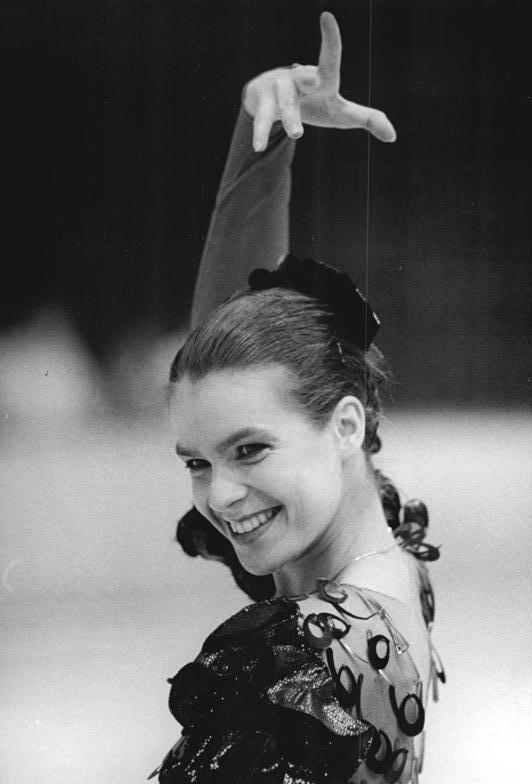
In 1988, Witt achieved her sixth consecutive European Championship, a feat that equaled Sonja Henie's record for the most successful skater in ladies' singles at the European Championships. While Irina Slutskaya later surpassed their total number of European titles, Witt continues to share the record with Henie for the most consecutive European titles.
The 1988 Winter Olympics in Calgary, Alberta, Canada, were highly anticipated due to the intense rivalry between Witt and Debi Thomas, dubbed the "Battle of the Carmens" as both chose music from Georges Bizet's opera Carmen for their long programs. After the compulsory figures and the short program, Thomas held the top spot, with Witt in second. In her long program, Witt successfully landed four triple jumps but downgraded a planned triple loop to a double loop. This opened the door for Thomas to win, but Thomas faltered, missing three of her five planned triple jumps. Canadian skater Elizabeth Manley won the long program convincingly over Witt (seven judges to two), but Witt secured her second consecutive Olympic gold medal based on her overall scores, having finished ahead of Manley in both the compulsory figures and the short program. Witt became only the second woman in figure skating history, after Sonja Henie, to successfully defend an Olympic title. The North Korean government issued miniature sheets featuring Witt on ice to honor her Calgary victory. Time magazine famously referred to her as "the most beautiful face of socialism," highlighting her iconic status within the Eastern Bloc.
Witt concluded her amateur career by winning her fourth and final World title at the 1988 World Figure Skating Championships in Budapest, Hungary. Her long program at this event was somewhat lackluster, with missed triple loop and triple salchow attempts, and did not match the quality of her Olympic performance. However, with other top contenders also performing below par due to post-Olympic fatigue, Witt secured the gold. She won the compulsory figures, finished second to Debi Thomas in the short program, and won the long program. Elizabeth Manley, who won silver, later voiced concerns about perceived questionable decisions during the event, including Witt's victory in figures and issues with Manley's music during her short program. On November 1, 1988, North Korea released a block of postage stamps specifically to honor Witt's Olympic victory.
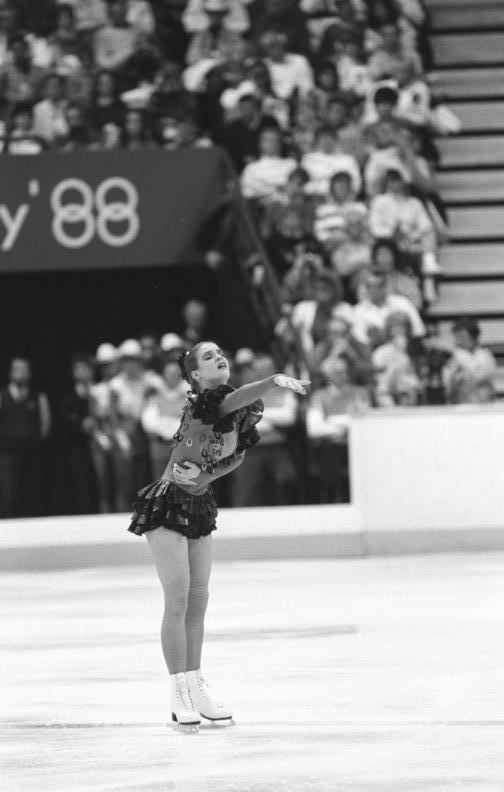
3.3. Skating Style and Costume Controversies
Katarina Witt's distinctive approach to figure skating costumes often sparked debate and even led to changes in international regulations. At the 1983 European Figure Skating Championships, she skated her Mozart short program in knee breeches instead of a traditional skirt, challenging conventional attire. Her blue, skirtless, feather-trimmed costume for a showgirl-themed short program in 1988 was widely regarded as overly theatrical and revealing. This led to a modification of the ISU regulations, commonly referred to as the "Katarina Rule," which mandated that female skaters wear more modest clothing, specifically requiring skirts to cover the buttocks and crotch area. In 1994, when Witt skated her Robin Hood-themed program, she explicitly stated, "I wore the Robin Hood - like a man's costume - because I didn't want to be accused of seducing the judges this time." This highlights her awareness of, and response to, the past controversies surrounding her attire and the pressure on female skaters to conform to specific aesthetic standards.
3.4. Retirement from Amateur Skating
Following her successful defense of the Olympic title in 1988 and securing her fourth World Championship, Katarina Witt made the decision to retire from amateur figure skating. This marked the end of an exceptionally dominant period in her competitive career.
4. Professional Career and Return to Competition
After her initial retirement from amateur skating, Katarina Witt transitioned into a highly successful professional career, eventually making a notable comeback to competitive skating.
4.1. Early Professional Activities
Witt's move to a professional career in 1989 was a rare occurrence for East German athletes at the time, given the strict controls on citizens' activities. She embarked on a three-year tour across the United States with fellow Olympic champion Brian Boitano. Their ice show, "Witt and Boitano Skating," proved immensely popular, notably selling out New York's Madison Square Garden for an ice show for the first time in a decade. Following this, she continued to perform with Holiday on Ice in both the United States and Western Europe. Witt also ventured into acting, starring in the 1989 film Carmen on Ice, which expanded upon her gold-medal winning free program from Calgary. For her performance in this film, she received an Emmy Award in 1990. While her professional competitive results were not as dominant as her amateur ones, she consistently garnered acclaim as an entertainer and show skater.
4.2. 1994 Olympic Comeback
In 1994, Katarina Witt made a highly anticipated return to competitive skating, once again under the tutelage of Jutta Müller. This comeback was particularly significant as she was aiming to represent a reunified Germany, a stark contrast to her previous representations of East Germany. Witt faced stiff competition for one of Germany's two Olympic spots, contending with younger rising star Tanja Szewczenko and veteran Marina Kielmann. She placed second at the German Figure Skating Championships behind Szewczenko, securing her qualification. Her first international competition for unified Germany was the 1994 European Figure Skating Championships, where she finished eighth, behind Szewczenko (fifth) but ahead of Kielmann (ninth). This performance ensured her and Szewczenko's spots for the 1994 Winter Olympics in Lillehammer, Norway.
At the Lillehammer Games, Witt finished seventh overall. A highlight of her performance was her clean and confident short program, which placed her sixth and earned her a spot in the final flight of the long program, a feat few had expected prior to the Games. In a dramatic turn of events, she was also the last skater to perform in the ladies' free skate, closing the show after the medalists had already been determined. Her free program, set to an arrangement of Pete Seeger's folk song "Where Have All the Flowers Gone?" (Sag mir wo die Blumen sindGerman), delivered a poignant peace message to the people of Sarajevo, the city where she had won her first Olympic gold medal, which had since been ravaged by war. While she experienced some technical difficulties, completing only three of her five planned triple jumps, her performance was widely regarded as one of the most emotional and moving of the entire evening. Her inspiring Olympic comeback earned her the prestigious Goldene Kamera award.
5. Post-Skating Activities and Public Life
Following her final retirement from competitive skating, Katarina Witt engaged in a wide array of activities, extending her influence into media, acting, and public service.
5.1. Media Appearances and Acting
Katarina Witt transitioned into a prominent media figure after her skating career. In 1996, she had cameo appearances in the Hollywood film Jerry Maguire and on the popular television show Everybody Loves Raymond. She later starred in a German-language film titled Die Eisprinzessin (The Ice Princess), for which she also provided the vocals for the theme song, "Skate with Me". She appeared as herself in two episodes of the comedy series Arli$ in 1997 and 1998.
In a highly publicized move, Witt posed nude for Playboy magazine, with her photographs appearing in the December 1998 issue. This particular issue became the magazine's second-ever sold-out edition, the first being the inaugural issue featuring Marilyn Monroe. Witt stated that her motivation for posing was to challenge the conventional "cute, pretty, ice princess image" often associated with figure skaters, expressing a desire to "change people's perceptions" and assert her own identity beyond the rink. In 1998, she also took on a small supporting role with several lines of dialogue in the film Ronin and played a villain in an episode of the television series V.I.P.. In November 2005, Witt published her novel, Only with Passion, a fictional work offering advice to a young skater, drawing from her extensive experience in the sport. From October 2006, she hosted her own television show, Stars auf EisGerman ("Stars on Ice"), on the German channel ProSieben. In 2007, she was invited as an honored guest to the Turkish skating competition TV show Buzda Dans ("Dance on Ice"). In December 2011, Witt was confirmed as a judge on the UK television show Dancing on Ice, making her first appearance in January 2012. In January 2013, Witt took on her first leading role in a German television movie titled Der Feind in meinem LebenGerman (The Stalker), playing a figure skater pursued by a stalker, a role with autobiographical elements as Witt herself had been stalked in the United States two decades prior.
5.2. Other Public Engagements
Beyond her media and acting career, Katarina Witt has been involved in various public and sports administration roles. In 1996, she received the Golden Plate Award from the American Academy of Achievement. In July 2007, Witt participated as a competitor in the German segment of the Live Earth concert in Hamburg. Most notably, she served as the head of Munich's unsuccessful bid to host the 2018 Winter Olympics. This role attracted significant media attention, particularly due to a perceived "new vs. old queen" rivalry with Yuna Kim, the South Korean Olympic gold medalist who served as an ambassador for the successful PyeongChang bid.
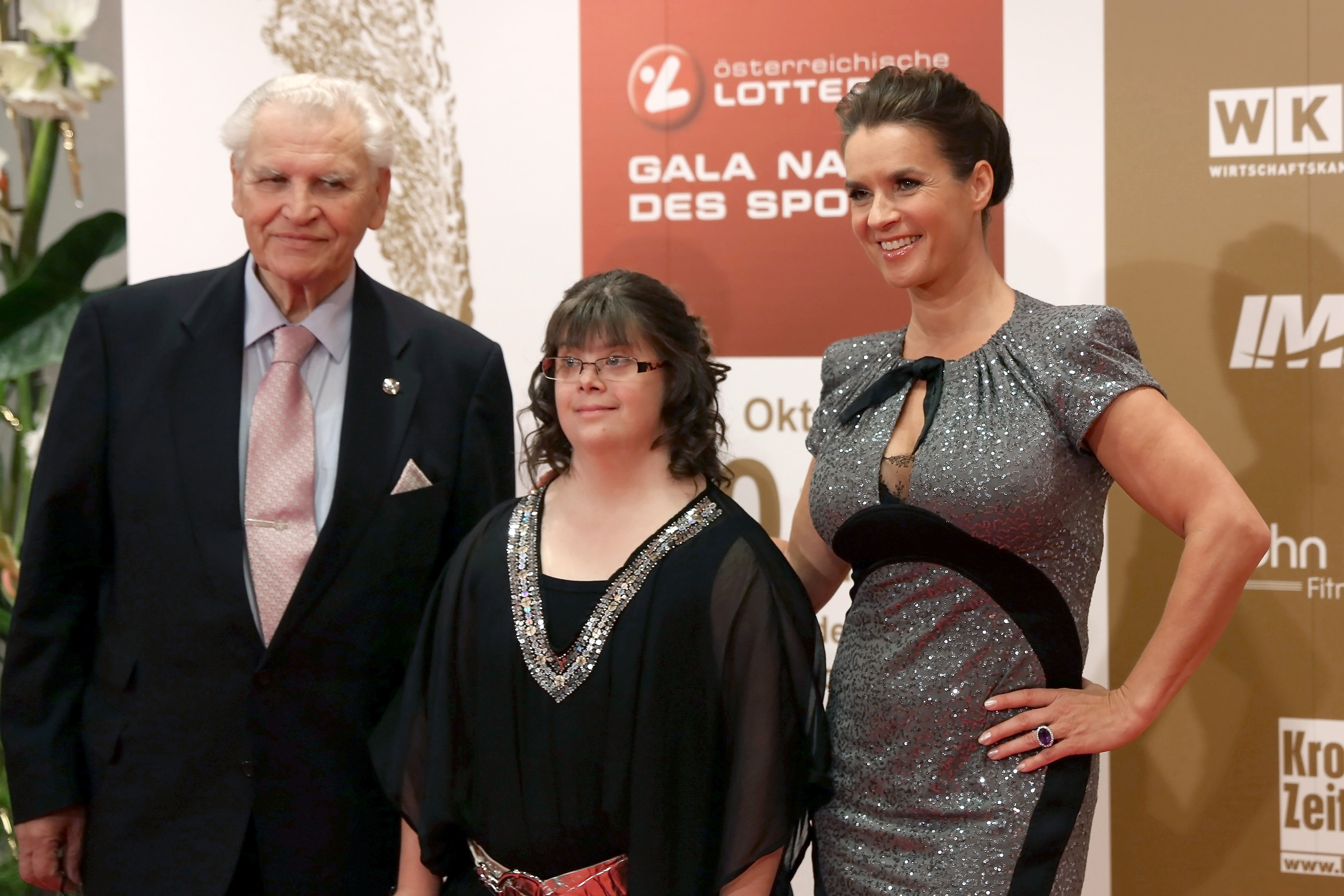
6. Relationship with East Germany and Stasi
Katarina Witt's career and personal life were inextricably linked with the East German regime, and her experiences provide a critical insight into the relationship between state power and individual freedom in a socialist state. Following the dissolution of East Germany, Stasi (State Security Service) files revealed the extent to which the secret police monitored and managed her life. Witt herself discovered 3,500 pages of documentation on her life, beginning from when she was just seven years old.
The Stasi actively worked to prevent Witt's defection to the West, a common concern for the regime regarding its highly successful international athletes. To ensure her loyalty and continued representation of East Germany, the Stasi provided her with privileges such as cars, favorable accommodation, and permissions for international travel, which were largely restricted for ordinary citizens. This preferential treatment was a strategic measure to keep her satisfied and reduce any incentive to defect.
Witt was often referred to as an "idol of the Honecker regime" and was extensively used as a political advertisement or "advertising face" for East Germany due to her beauty and international success. This strategic utilization of her image highlights how the state leveraged its athletic achievements for propaganda purposes, effectively commodifying individuals for political gain. Witt later confessed in her autobiography about her private life being meticulously documented in state files and the pressure she faced to provide information as a Stasi collaborator. Her experiences vividly illustrate the intrusive nature of state surveillance and the compromises individuals were forced to make under authoritarian rule.
7. Legacy and Reception
Katarina Witt's legacy in figure skating is profound, marking her as one of the sport's most influential and celebrated figures, though her career also navigated significant societal and political complexities.
7.1. Achievements and Positive Evaluation
Witt is widely regarded as one of the greatest ladies' singles figure skaters of all time, distinguishing herself with both her athletic ability and artistic expression. Her Laureus profile emphasizes that she is "remembered most for her overall athleticism, her charismatic appeal and her glamorous image on the ice." Between 1984 and 1988, her dominance was undeniable, as she secured ten gold medals from eleven major international events, making her one of the most successful figure skaters in history. Her performances were characterized by a captivating blend of technical precision and artistic flair, often pushing the boundaries of presentation in the sport. Witt's ability to engage with the audience and deliver memorable programs, particularly her iconic Carmen performance, set a new standard for charismatic artistry on ice.
7.2. Criticism and Controversies
Despite her widespread acclaim, Katarina Witt's career was not without criticism and controversy, particularly concerning her costumes and her association with the East German state. The debates surrounding her skating attire were notable. For instance, her decision to wear knee breeches at the 1983 European Championships challenged traditional perceptions of figure skating costumes. Even more significantly, her revealing, skirtless blue costume for a 1988 short program led to the implementation of the "Katarina Rule" by the ISU, requiring more modest clothing for female skaters. Witt, however, often responded to such criticisms with confidence, asserting that beauty was an integral part of ice skating and that she sought to challenge preconceived notions of what a figure skater should embody.
The revelations from the Stasi files after German reunification presented a deeper, more critical dimension to her public image. While the files documented how the East German regime went to great lengths to prevent her defection by granting her privileges, they also exposed the pervasive state surveillance and control over her personal life. This aspect of her biography has led to discussions about the ethical implications of athletes serving as symbols for authoritarian states, and the difficult choices individuals faced under such regimes. Witt's acknowledgment of these realities in her autobiography contributed to a more nuanced understanding of her experiences within the complex political landscape of East Germany.
8. Awards and Recognition
Katarina Witt has received numerous prestigious awards and recognitions throughout and after her illustrious career, highlighting her significant impact on sports and public life.
- GDR Female Athlete of the Year**: Voted "GDR Female Athlete of the Year" by the readers of the East German newspaper Junge Welt in 1984.
- Emmy Award**: Received an Emmy Award in 1990 for her starring role in the film Carmen on Ice.
- Golden Camera**: Awarded the Goldene Kamera in 1994 for her inspiring comeback at the 1994 Lillehammer Winter Olympics.
- World Figure Skating Hall of Fame**: Inducted into the World Figure Skating Hall of Fame in 1995, acknowledging her outstanding contributions to the sport.
- Golden Plate Award**: Received the Golden Plate Award of the American Academy of Achievement in 1996.
- Postage Stamps**: The North Korean government issued miniature sheets and a block of postage stamps featuring Witt in 1988, commemorating her Olympic victory in Calgary. She also appeared on an Azerbaijani postage stamp.
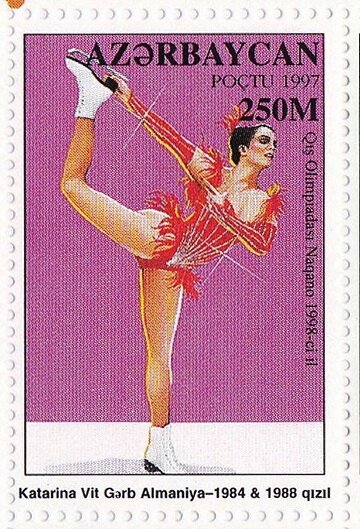
9. Skating Programs
Katarina Witt was renowned for her captivating skating programs, which often blended athletic skill with artistic interpretation. The following table lists the music and themes used in her notable short and free skating programs during her competitive years.
| Season | Short program | Free skating | Exhibition | ||||
|---|---|---|---|---|---|---|---|
| 1993-1994 | Robin Hood: Prince of Thieves by Michael Kamen | Where Have All the Flowers Gone? by Pete Seeger Arrangement by Burt Bacharach | |||||
| 1987-1988 | Jerry's Girls by Jerry Herman | Carmen by Georges Bizet and Rodion Shchedrin | by Rita Hayworth
>- | 1986-1987 | In the Mood by Glenn Miller | West Side Story by Leonard Bernstein | Hernando's Hideaway (from The Pajama Game) |
| 1985-1986 | Theme from Caravans by Mike Batt | Make Believe It's Your First Time by The Carpenters | French Cancan | ||||
| 1984-1985 | Flamenco Fantasy | *I Got Rhythm
| La Malagueña | |||||
| 1983-1984 | Csárdás by Vittorio Monti | Love Me Tender by Elvis Presley
> | |||||
| 1982-1983 |
>Rhapsody in Black | ||||||
| 1981-1982 | Superman by John Williams | ||||||
| 1980-1981 | The Muppet Show |
10. Competition Results
Katarina Witt's competition results highlight her consistent excellence and dominance in ladies' singles figure skating over more than a decade.
| Event | 1978-79 | 1979-80 | 1980-81 | 1981-82 | 1982-83 | 1983-84 | 1984-85 | 1985-86 | 1986-87 | 1987-88 | 1993-94 |
|---|---|---|---|---|---|---|---|---|---|---|---|
| Olympics | 1st | 1st | 7th | ||||||||
| Worlds | 10th | 5th | 2nd | 4th | 1st | 1st | 2nd | 1st | 1st | ||
| Europeans | 14th | 13th | 5th | 2nd | 1st | 1st | 1st | 1st | 1st | 1st | 8th |
| Skate Canada | 1st | ||||||||||
| NHK Trophy | 2nd | 1st | 1st | 1st | |||||||
| Blue Swords | 1st | 2nd | 1st | ||||||||
| International Challenge Cup | 2nd | 1st | 1st | ||||||||
| Golden Spin of Zagreb | 3rd | ||||||||||
| East German | 3rd | 2nd | 1st | 1st | 1st | 1st | 1st | 1st | 1st | 1st | |
| German | 2nd |
11. Bibliography
Katarina Witt has been the subject of and contributor to several significant publications that shed light on her career and life experiences.
Her autobiography, Meine Jahre zwischen Pflicht und KürGerman (My Years between Compulsories and FreestyleEnglish), was published in 1994. This work provides her personal account of her life and career, including her experiences under the East German regime. The Japanese translation of this autobiography is titled メダルと恋と秘密警察-ビットが明かす銀盤人生Japanese (Medals, Love, and the Secret Police: Witt Reveals Her Life on the IceEnglish), published by Bungeishunju.
In 2005, Johanna Beisteiner's PhD thesis, Kunstmusik in Eiskunstlauf, Synchronschwimmen und rhythmischer GymnastikGerman (Art Music in Figure Skating, Synchronized Swimming and Rhythmic GymnasticsEnglish), included an extensive description and analysis of Witt's film Carmen on Ice.
In November 2005, Witt published her novel, Only with Passion, a fictional work offering advice to a young skater based on her many years of experience in the sport.